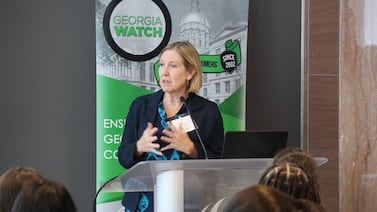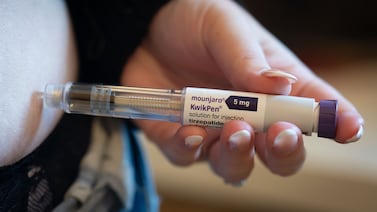Public health, explained: Sign up to receive Healthbeat’s free Atlanta newsletter here.
There’s no question that the coming summer in Atlanta will be a scorcher. But exactly how hot it will get can vary greatly in pockets across the metro area, creating uneven health risks.
Experts don’t have the data from the many places where people live, work, and play outdoors to track those extreme temperatures. Atlanta has only one “class 1” weather station that can provide high-quality data over a long historical period, and it’s at Hartsfield-Jackson Atlanta International Airport, though there are more weather stations across the metro region.
“The heat risk in one neighborhood is actually dramatically different than the heat risk in another neighborhood, and we have almost no information on that,” said Brian Stone, a professor who runs the Urban Climate Lab at Georgia Tech.
The lack of temperature data across the metro area makes it difficult for leaders to address the decades of rising temperatures, which pose a public health threat.
“Atlanta now experiences nearly two weeks worth of extreme heat days per year than it did in 1970 — part of a broader trend in which nearly every U.S. city is heating up,” said Dr. Kristina Dahl, vice president for science at nonprofit Climate Central.
A 2021 study found that Atlanta had 19 heat-related deaths each year attributable to human-induced climate change between 1991 and 2006.
Air temperature and humidity combine to affect health
Stone said there are many sources of heat data, but each has limitations.
Satellites capture surface temperature – how a street would feel if you touch it – but not the combination of temperature and humidity that drive health impacts from heat.
The Atlanta metro area should develop a more robust monitoring system, he said.
He pointed to Philadelphia, which developed a map that shows detailed heat risk by census tract, as well as where people can access cooling stations and other services to help with heat.
Stone’s lab uses climate models to help cities understand which neighborhoods have higher temperatures and how measures like adding trees or cool roofing to buildings could lower those temperatures.
One study Stone conducted for the City of Atlanta in 2023 found different neighborhoods face wide differences in heat risks. Areas with higher density had higher summer temperatures, while those with more tree canopy had lower temperatures.
While the English Avenue neighborhood had a heat vulnerability score of 10 — the highest in the city — nearby Georgia Tech had a score of 4. Neighborhoods to the west and south of the city center showed the highest total levels of heat vulnerability, on average.
That study also found that the prevalence of central air conditioning across the city was 96% but as low as 80% in some westside neighborhoods.
An Atlanta-based project called GEM, for Greenlink Equity Map, created by nonprofit Greenlink Analytics, measures urban heat using a nighttime temperature and converts it into a heat index for different neighborhoods in many cities.
The map presents data about the entire metro region and can show data about health and climate-related variables like utility burden – how much of a person’s income goes to energy costs – and tree canopy in different neighborhoods, said Matt Cox, CEO and executive director of Greenlink.
Some neighborhoods in Atlanta have a lot of tree canopy but still experience a high energy burden, which means people may not be able to afford air conditioning or must make choices between food and medicine or utilities.
It’s important to record nighttime temperatures that reflect accumulated heat over the day, but many models use morning or daytime measures, which tend to be lower. The Greenlink map uses nighttime temperature measures from satellites coupled with machine learning to produce its data.
The City of Atlanta is updating its climate resilience plan, which will include recommendations to address extreme heat, spokesperson Rayna Plummer said.
The city is planning several community engagement events related to climate resilience this summer.
Citizen scientists help collect temperature data
In Gwinnett County one day last August, 20 volunteers drove around a 27-square-mile area with thermometers to track the temperature at different times of day, part of a federal effort to enlist local volunteers to track urban heat since 2017.
Citizen science projects like the one-day temperature mapping effort help people learn more about heat and get them involved, Stone said. But the data’s single-day focus is limited.
Still, the project helped show where “urban heat islands” are and which areas lack tree canopy, said state Rep. Marvin Lim, who helped lead the effort.
Lim said his greatest insight from the data was that “unless there were significant trees between heavy-use roads/industrial areas and residential areas … adjacent residential areas were still going to be very hot.”
“It made me think of how difficult it is for trees to exist in these kind of urban landscapes - the impervious surfaces are going to reduce their cooling effect, which means, in my mind, you really need a significant number of trees in these areas,” Lim said.
In concrete terms, the data helped influence a decision to apply for a grant from the American Academy of Dermatology to build a shaded bus shelter along Jimmy Carter Boulevard in Gwinnett. That was driven by the heat mapping project and determining where people walked a lot.
The location at Nett Church was chosen “because it gets hot there (little tree cover, industrial area), but people are frequently walking in that area.”
DeKalb County is working on a tree canopy study that will establish a baseline map and track changes over time in unincorporated areas, according to its website.
In Cobb County, a class of Georgia Tech students working with Professor Jairo Garcia mapped heat islands in 2022. They also provided recommendations, suggesting the county develop a climate resiliency plan.
The county is working on it, Chief Sustainability Officer Kimberly White told Healthbeat, though it’s in early stages.
Rebecca Grapevine is a reporter covering public health in Atlanta for Healthbeat. Contact Rebecca at rgrapevine@healthbeat.org.






